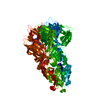[English] 日本語
 Yorodumi
Yorodumi- PDB-3j05: Three-dimensional structure of Dengue virus serotype 1 complexed ... -
+ Open data
Open data
- Basic information
Basic information
| Entry | Database: PDB / ID: 3j05 | ||||||
|---|---|---|---|---|---|---|---|
| Title | Three-dimensional structure of Dengue virus serotype 1 complexed with HMAb 14c10 Fab | ||||||
 Components Components | envelope protein | ||||||
 Keywords Keywords | VIRUS / flavivirus / dengue / serotype 1 / envelope protein / E protein / mature virus | ||||||
| Function / homology |  Function and homology information Function and homology informationsymbiont-mediated suppression of host JAK-STAT cascade via inhibition of host TYK2 activity / host cell mitochondrion / symbiont-mediated suppression of host JAK-STAT cascade via inhibition of STAT2 activity / symbiont-mediated suppression of host cytoplasmic pattern recognition receptor signaling pathway via inhibition of MAVS activity / ribonucleoside triphosphate phosphatase activity / viral capsid / double-stranded RNA binding / channel activity / monoatomic ion transmembrane transport / clathrin-dependent endocytosis of virus by host cell ...symbiont-mediated suppression of host JAK-STAT cascade via inhibition of host TYK2 activity / host cell mitochondrion / symbiont-mediated suppression of host JAK-STAT cascade via inhibition of STAT2 activity / symbiont-mediated suppression of host cytoplasmic pattern recognition receptor signaling pathway via inhibition of MAVS activity / ribonucleoside triphosphate phosphatase activity / viral capsid / double-stranded RNA binding / channel activity / monoatomic ion transmembrane transport / clathrin-dependent endocytosis of virus by host cell / methyltransferase cap1 activity / mRNA 5'-cap (guanine-N7-)-methyltransferase activity / RNA helicase activity / protein dimerization activity / host cell endoplasmic reticulum membrane / symbiont-mediated suppression of host type I interferon-mediated signaling pathway / symbiont-mediated activation of host autophagy / serine-type endopeptidase activity / viral RNA genome replication / RNA-directed RNA polymerase activity / fusion of virus membrane with host endosome membrane / viral envelope / virion attachment to host cell / host cell nucleus / virion membrane / structural molecule activity / proteolysis / extracellular region / ATP binding / metal ion binding / membrane Similarity search - Function | ||||||
| Biological species |  Dengue virus 1 Dengue virus 1 | ||||||
| Method | ELECTRON MICROSCOPY / single particle reconstruction / cryo EM / Resolution: 7 Å | ||||||
 Authors Authors | Teoh, E.P. / Kukkaro, P. / Teo, E.W. / Lim, A. / Tan, T.T. / Shi, P.Y. / Yip, A. / Schul, W. / Leo, Y.S. / Chan, S.H. ...Teoh, E.P. / Kukkaro, P. / Teo, E.W. / Lim, A. / Tan, T.T. / Shi, P.Y. / Yip, A. / Schul, W. / Leo, Y.S. / Chan, S.H. / Smith, K.G.C. / Ooi, E.E. / Kemeny, D.M. / Ng, G. / Ng, M.L. / Alonso, S. / Fisher, D. / Hanson, B. / Lok, S.M. / MacAry, P.A. | ||||||
 Citation Citation |  Journal: Sci Transl Med / Year: 2012 Journal: Sci Transl Med / Year: 2012Title: The structural basis for serotype-specific neutralization of dengue virus by a human antibody. Authors: Ee Ping Teoh / Petra Kukkaro / En Wei Teo / Angeline P C Lim / Tze Tong Tan / Andy Yip / Wouter Schul / Myint Aung / Victor A Kostyuchenko / Yee Sin Leo / Soh Ha Chan / Kenneth G C Smith / ...Authors: Ee Ping Teoh / Petra Kukkaro / En Wei Teo / Angeline P C Lim / Tze Tong Tan / Andy Yip / Wouter Schul / Myint Aung / Victor A Kostyuchenko / Yee Sin Leo / Soh Ha Chan / Kenneth G C Smith / Annie Hoi Yi Chan / Gang Zou / Eng Eong Ooi / D Michael Kemeny / Grace K Tan / Jowin K W Ng / Mah Lee Ng / Sylvie Alonso / Dale Fisher / Pei-Yong Shi / Brendon J Hanson / Shee-Mei Lok / Paul A MacAry /  Abstract: Dengue virus (DENV) is a mosquito-borne flavivirus that affects 2.5 billion people worldwide. There are four dengue serotypes (DENV1 to DENV4), and infection with one elicits lifelong immunity to ...Dengue virus (DENV) is a mosquito-borne flavivirus that affects 2.5 billion people worldwide. There are four dengue serotypes (DENV1 to DENV4), and infection with one elicits lifelong immunity to that serotype but offers only transient protection against the other serotypes. Identification of the protective determinants of the human antibody response to DENV is a vital requirement for the design and evaluation of future preventative therapies and treatments. Here, we describe the isolation of a neutralizing antibody from a DENV1-infected patient. The human antibody 14c10 (HM14c10) binds specifically to DENV1. HM14c10 neutralizes the virus principally by blocking virus attachment; at higher concentrations, a post-attachment step can also be inhibited. In vivo studies show that the HM14c10 antibody has antiviral activity at picomolar concentrations. A 7 Å resolution cryoelectron microscopy map of Fab fragments of HM14c10 in a complex with DENV1 shows targeting of a discontinuous epitope that spans the adjacent surface of envelope protein dimers. As found previously, a human antibody specific for the related West Nile virus binds to a similar quaternary structure, suggesting that this could be an immunodominant epitope. These findings provide a structural and molecular context for durable, serotype-specific immunity to DENV infection. | ||||||
| History |
|
- Structure visualization
Structure visualization
| Movie |
 Movie viewer Movie viewer |
|---|---|
| Structure viewer | Molecule:  Molmil Molmil Jmol/JSmol Jmol/JSmol |
- Downloads & links
Downloads & links
- Download
Download
| PDBx/mmCIF format |  3j05.cif.gz 3j05.cif.gz | 46.7 KB | Display |  PDBx/mmCIF format PDBx/mmCIF format |
|---|---|---|---|---|
| PDB format |  pdb3j05.ent.gz pdb3j05.ent.gz | 29.1 KB | Display |  PDB format PDB format |
| PDBx/mmJSON format |  3j05.json.gz 3j05.json.gz | Tree view |  PDBx/mmJSON format PDBx/mmJSON format | |
| Others |  Other downloads Other downloads |
-Validation report
| Summary document |  3j05_validation.pdf.gz 3j05_validation.pdf.gz | 904.1 KB | Display |  wwPDB validaton report wwPDB validaton report |
|---|---|---|---|---|
| Full document |  3j05_full_validation.pdf.gz 3j05_full_validation.pdf.gz | 906 KB | Display | |
| Data in XML |  3j05_validation.xml.gz 3j05_validation.xml.gz | 21.8 KB | Display | |
| Data in CIF |  3j05_validation.cif.gz 3j05_validation.cif.gz | 31.1 KB | Display | |
| Arichive directory |  https://data.pdbj.org/pub/pdb/validation_reports/j0/3j05 https://data.pdbj.org/pub/pdb/validation_reports/j0/3j05 ftp://data.pdbj.org/pub/pdb/validation_reports/j0/3j05 ftp://data.pdbj.org/pub/pdb/validation_reports/j0/3j05 | HTTPS FTP |
-Related structure data
| Related structure data |  5268MC  4cauC M: map data used to model this data C: citing same article ( |
|---|---|
| Similar structure data |
- Links
Links
- Assembly
Assembly
| Deposited unit | 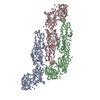
|
|---|---|
| 1 | x 60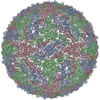
|
| 2 |
|
| 3 | x 5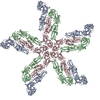
|
| 4 | x 6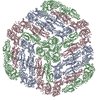
|
| 5 | 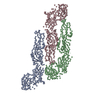
|
| Symmetry | Point symmetry: (Schoenflies symbol: I (icosahedral)) |
- Components
Components
| #1: Protein | Mass: 43750.883 Da / Num. of mol.: 3 Source method: isolated from a genetically manipulated source Source: (gene. exp.)  Dengue virus 1 / Plasmid: pMTBip/V5-His / Cell line (production host): S2 / Production host: Dengue virus 1 / Plasmid: pMTBip/V5-His / Cell line (production host): S2 / Production host:  Sequence details | THE AUTHORS STATE THAT THERE ARE NO SEQUENCE CONFLICTS BETWEEN THE SEQUENCE IN THE PDB FILE AND ...THE AUTHORS STATE THAT THERE ARE NO SEQUENCE CONFLICTS BETWEEN THE SEQUENCE IN THE PDB FILE AND SEQUENCE DATABASE REFERENCE NCBI BAD42413. | |
|---|
-Experimental details
-Experiment
| Experiment | Method: ELECTRON MICROSCOPY |
|---|---|
| EM experiment | Aggregation state: PARTICLE / 3D reconstruction method: single particle reconstruction |
- Sample preparation
Sample preparation
| Component | Name: Dengue virus serotype 1 with Fab fragment of human monoclonal antibody 14c10 Type: COMPLEX / Details: 120 Fab molecules bind to one dengue virion |
|---|---|
| Details of virus | Empty: NO / Enveloped: YES / Host category: INVERTERBRATES / Isolate: STRAIN / Type: VIRION |
| Natural host | Organism: Aedes albopictus |
| Buffer solution | pH: 8 / Details: 120 mM NaCl, 12 mM Tris-HCl, pH 8.0, 1 mM EDTA |
| Specimen | Embedding applied: NO / Shadowing applied: NO / Staining applied: NO / Vitrification applied: YES / Details: 120 mM NaCl, 12 mM Tris-HCl, pH 8.0, 1 mM EDTA |
| Vitrification | Instrument: FEI VITROBOT MARK I / Cryogen name: ETHANE / Humidity: 100 % / Method: 1 second blotting |
- Electron microscopy imaging
Electron microscopy imaging
| Experimental equipment |  Model: Titan Krios / Image courtesy: FEI Company |
|---|---|
| Microscopy | Model: FEI TITAN KRIOS / Date: Sep 27, 2010 |
| Electron gun | Electron source:  FIELD EMISSION GUN / Accelerating voltage: 300 kV / Illumination mode: SPOT SCAN FIELD EMISSION GUN / Accelerating voltage: 300 kV / Illumination mode: SPOT SCAN |
| Electron lens | Mode: BRIGHT FIELD / Nominal magnification: 47000 X / Nominal defocus max: 4900 nm / Nominal defocus min: 760 nm / Cs: 2.7 mm / Camera length: 0 mm |
| Specimen holder | Specimen holder model: OTHER / Specimen holder type: Titan krios cryoholder / Temperature: 100 K / Tilt angle max: 0 ° / Tilt angle min: 0 ° |
| Image recording | Electron dose: 16 e/Å2 / Film or detector model: GENERIC GATAN |
| Radiation | Protocol: SINGLE WAVELENGTH / Monochromatic (M) / Laue (L): M / Scattering type: x-ray |
| Radiation wavelength | Relative weight: 1 |
- Processing
Processing
| EM software |
| ||||||||||||
|---|---|---|---|---|---|---|---|---|---|---|---|---|---|
| CTF correction | Details: each particle | ||||||||||||
| Symmetry | Point symmetry: I (icosahedral) | ||||||||||||
| 3D reconstruction | Method: Cross-common lines / Resolution: 7 Å / Resolution method: FSC 0.5 CUT-OFF / Num. of particles: 2129 / Nominal pixel size: 1.9 Å / Actual pixel size: 1.9 Å / Details: particles were selected manually / Symmetry type: POINT | ||||||||||||
| Atomic model building | Protocol: RIGID BODY FIT / Space: REAL / Target criteria: correlation Details: REFINEMENT PROTOCOL--rigid body DETAILS--The domains were fitted separately using Fit In Map feature in Chimera | ||||||||||||
| Atomic model building | PDB-ID: 3G7T Accession code: 3G7T / Source name: PDB / Type: experimental model | ||||||||||||
| Refinement step | Cycle: LAST
|
 Movie
Movie Controller
Controller


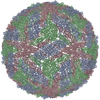

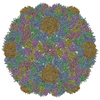

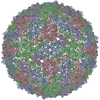



 PDBj
PDBj

